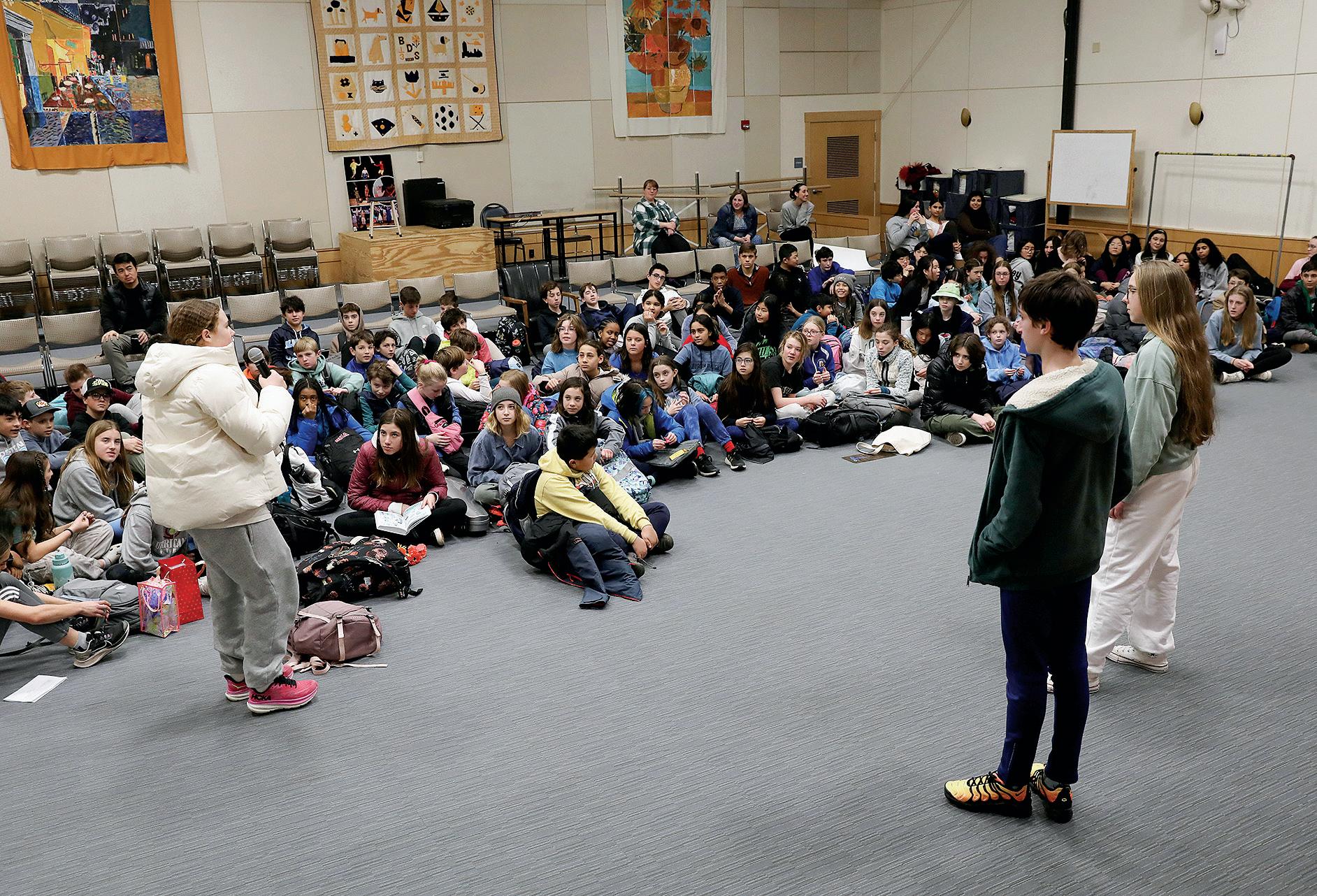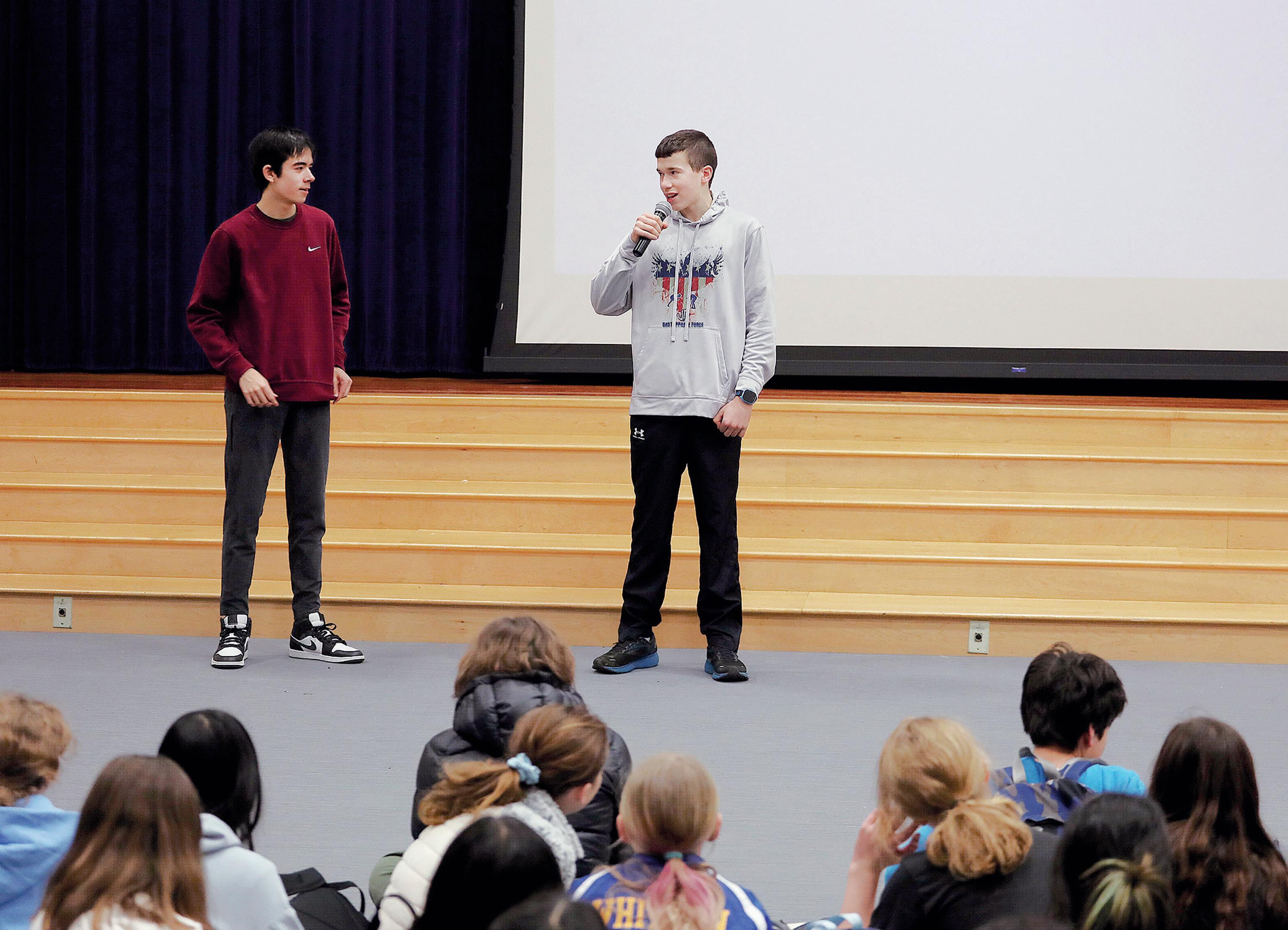
5 minute read
Weekly Meeting Builds Caring Community
One Friday at a Time
Take all Belmont Day’s middle schoolers and their teachers and put them into a room each week. Give them a chance to highlight the new and good, share talents and interests, and show leadership. Add a little humor (okay, a lot!), and what do you get?
The answer is a new-ish model for middle school meetings, which in its second year is proving to be a powerful vehicle for amplifying student voices and building school culture.
Belmont Day is, of course, already a school with a strong tradition around community gatherings. Schoolwide sharing assemblies have long been a vital connection point. However, the middle school did not have a single moment each week when all its students could gather. Faculty leaders saw an opportunity to establish a space where middle schoolers could serve and lead. Core values are woven throughout the time together as students take on new roles, share moments of joy, and care for each other.
“There was an opportunity to pull together the community and strengthen our middle school culture,” says John O’Neill, director of athletics. “Our question was, where did that middle school identity live? We felt there was a need for this. Our thought was, how do we do so in a way that is more student-driven than faculty-driven?”
The final product is all about the students, but thoughtful faculty planning happened behind the scenes. “We spend a lot of time thinking and talking and working to make these 20-minute meetings impactful,” says Jen Friborg, who wears many hats, including fifth grade language, community, and culture teacher; seventh and eighth grade French teacher; and Capstone coordinator.
Middle school meetings occur on Fridays as a final connection before the weekends. Students sit in a U-shape so they can see each other. “The formula we designed provides a routine so students know what to expect and feel comfortable taking ownership,” says Kassie Bettinelli, a music and ensembles teacher. Teachers never need to ask students to be quiet to allow a speaker to be heard. “Everyone wants to listen to one another,” Kassie adds.

The general format is simple but intentional. Two student emcees lead the meeting and welcome those gathered. Students tell a couple of jokes and invite peers to share things that are new and good at Belmont Day. There is space for “community connections,” where students can share a hobby or interest they pursue outside of school. There are also moments to celebrate advisory groups, clubs, and community service.
New and good sharing is spontaneous, and as many new and good things do, this piece of the meeting has evolved. “We’ve done a lot of coaching around how to make a new and good share clear and provide context for it,” says Kassie. “We foster student engagement by encouraging them to ask follow-up questions or be clear before they raise their hand to share. We want them to consider whether someone not in their class or sports team or ensemble will understand.”
Students have shared academic highlights (a blood typing experiment) and milestone moments (turning in the first part of their Capstone papers). They celebrated the band performers and those who worked behind the scenes. Finally, and perhaps most powerfully, during community connections, middle schoolers give voice to the things outside of school that make them tick.
“It was gratifying,” says Jen, after one middle school meeting in the fall. “In one community share, several students and a faculty member talked about their involvement in dance. One student shared her pointe shoes, while another, who does rhythmic gymnastics, unfurled her ribbons and did a quick demonstration. To see students appreciate her for something she spends many hours doing each week was exciting.”
Community connections have featured dancers, swimmers, musicians, and a student who nurtures house plants. That student shared photos of the plants she propagated and spreadsheets she used to track her watering regimen. “It was amazing,” Kassie says. “Seeing students in the audience be surprised and remark ‘What? You’ve got a plant that’s older than your parents?’ Little facts like that were so neat.”
“It’s not a performance,” adds Jen, “but sharing interesting aspects of the world that we may not have considered. There is almost always a small group, which usually includes faculty. We are trying to show that we all have common ground and can learn from each other.”
John adds that many students have stepped forward into leadership roles in this venue, who have yet to in other places. Others who might feel nervous about sharing in the larger assembly feel at home here. “They learn about each other and feel part of a community,” Jen adds. “It’s contributing to a sense of caring.”
The adults admit that they are learning, too. Kassie says, “We are constantly tweaking or rethinking how we do this, and that’s representative of how we work here at BDS. We’re learning alongside students.”
Student 1: I saw a lot of cows
Student 2: How did you count them?
Student 1: I used a Cowculator
Student 2: I see you were a bear
Student 1: Yes you know Halloween was really crazy, hectic, busy....
Student 2: True.
Student 1: I just really need to paws and reflect.
Student 2: I can’t bear that joke.




